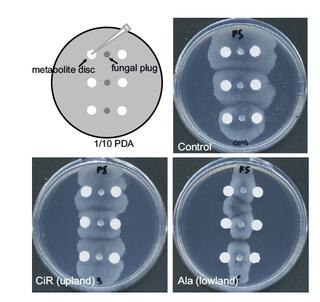Anti-fungal bioactive terpenoids in the bioenergy crop switchgrass (Panicum virgatum) may contribute to ecotype-specific microbiome composition
X. Li et al. "Anti-fungal bioactive terpenoids in the bioenergy crop switchgrass (Panicum virgatum) may contribute to ecotype-specific microbiome composition" Communications Biology 6:917 (2023) [DOI:10.1038/s42003-023-05290-3]
Plant derived bioactive small molecules have attracted attention of scientists across fundamental and applied scientific disciplines. We seek to understand the influence of these phytochemicals on rhizosphere and root-associated fungi. We hypothesize that - consistent with accumulating evidence that switchgrass genotype impacts microbiome assembly - differential terpenoid accumulation contributes to switchgrass ecotype-specific microbiome composition. An initial in vitro Petri plate-based disc diffusion screen of 18 switchgrass root derived fungal isolates revealed differential responses to upland- and lowland-isolated metabolites. To identify specific fungal growth-modulating metabolites, we tested fractions from root extracts on three ecologically important fungal isolates - Linnemania elongata, Trichoderma sp. and Fusarium sp. Saponins and diterpenoids were identified as the most prominent antifungal metabolites. Finally, analysis of liquid chromatography-purified terpenoids revealed fungal inhibition structure - activity relationships (SAR). Saponin antifungal activity was primarily determined by the number of sugar moieties - saponins glycosylated at a single core position were inhibitory whereas saponins glycosylated at two core positions were inactive. Saponin core hydroxylation and acetylation were also associated with reduced activity. Diterpenoid activity required the presence of an intact furan ring for strong fungal growth inhibition. These results inform future breeding and biotechnology strategies for crop protection with reduced pesticide application.
The raw data for LC-MS metabolomics and images of fungal bioassays are publicly available on DRYAD at https://doi.org/10.5061/dryad.stqjq2c7x. The rest of the data substantiating the conclusions of this study are available as Supplementary Figs. S1–S13, Supplementary Tables S1–S2 and Supplementary Data 1–5. Numerical source data for all fungal bioassay related graphs/charts can be found in Supplementary Data 6–13.
